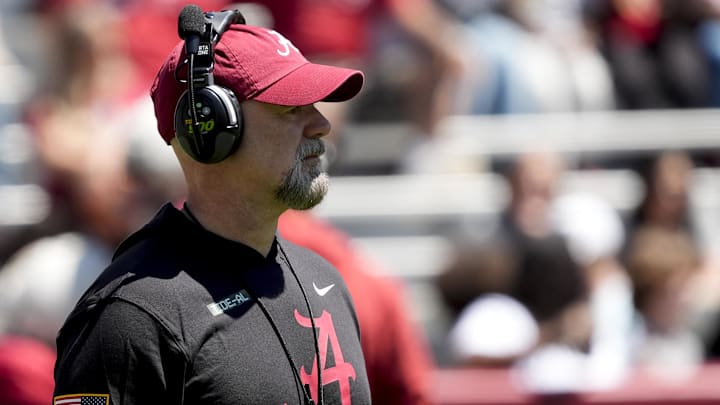With the new economics of college football, it’s hard to build the super-teams of years past. Although the amount may not be the same, every program has money to spend through revenue sharing, and the transfer portal allows players to move around to access it.
So, the best teams, even the SEC favorites, are going to have flaws; it’s virtually inevitable. Alabama’s biggest flaw this year has been the run game. The Crimson Tide are thin at running back after losing Justice Haynes to Michigan in the offseason, and Jam Miller has been injured for much of the year.
Because no roster will be infallible, coaching becomes even more important. Can you scheme around your deficiencies? Ryan Grubb, who is far from a run-game savant, has continually found answers for running the ball just enough, and some of them have been quite unconventional.
Table for 12 Week 8: Lane Kiffin couldn't land the knockout
An extension of the run-game
For one, Germie Bernard led the Tide in rushing yards against Tennessee, racking up 49 on four attempts, one of which was an attempted trick play where Bernard was looking to throw the ball before taking off. Those trick plays, whether it's jet sweeps to Bernard and Ryan Williams or QB keepers by left tackle Kadyn Proctor, have been part of Grubb’s answer for the ground game.
He also has Ty Simpson throw a high number of screen passes to serve as an extension of the run game. Those screens, which account for 17.8 percent of Simpson’s dropbacks, have averaged 8.0 yards per attempt with three touchdowns. That’s much more effective than the traditional run-game, which is averaging 3.7 yards per attempt and ranks 127th in the country in success rate.
Still, not everything can be a gadget play or an extension of the run game. Sometimes, you just have to run the ball, and again, Grubb seems to be evolving into an actual solution. More carries for redshirt freshman Daniel Hill, who went for 34 yards on seven attempts in Week 8, are part of it, but the more interesting aspect is schematic.
How to leverage your best athletes to run the ball
Alabama doesn’t have the interior offensive line to run the ball consistently between the tackles. It does, however, have an obscenely athletic offensive tackle in Proctor, and Grubb has leaned into that. 13 of Alabama’s 51 rushing first downs this season have come off the left end of the offensive line, including both rushing touchdowns against Tennessee and the game-sealing score in the final seconds of the win over Vanderbilt.
The window dressing has been different, but both of Miller’s rushing scores in the last two weeks, one on the goalline against Tennessee, and the other on a got-to-have-it fourth-down against Vandy, have come on pin-pull runs.
A pin-pull is a man-blocking scheme, which Grubb has favored over zone runs, and it’s designed to get to the perimeter. Look at Miller’s touchdown against Tennessee. The pre-snap motion from Josh Cuevas influences the second-level defenders, and the subtle movement allowed Kadyn Proctor to pull and get leverage on Tennessee’s second-level defenders to lead Miller in for the score after Germie Bernard pinned down the edge defender.
2️⃣6️⃣ 🙌
— Alabama Football (@AlabamaFTBL) October 19, 2025
📺: ABC pic.twitter.com/PKGYiyv9Re
It’s a perfect use of Bernard’s physicality and Proctor’s athleticism. Against Vanderbilt, it was a different formation, but again, Bernard and Proctor are two of the most important players. Proctor, along with Isaiah Horton, Cuevas, and Jay Lindsey, who were aligned in a bunch formation, pin down to seal the edge, while Bernard and left guard Kam Dewberry pull to lead the way for Miller.
ANGRY RUNS 😤@JamarionMiller1 pic.twitter.com/1OUtEZsooa
— Alabama Football (@AlabamaFTBL) October 4, 2025
Perimeter runs, and pin-pulls in particular, are becoming an increasingly integral part of Grubb’s run game. That schematic advantage, after favoring more zone runs between the tackles early in the season, hasn’t unlocked the rushing attack, but it’s made it more than passable for a team with such an accurate and efficient quarterback.
It felt significant when Grubb decided to join DeBoer in Tuscaloosa this offseason, and adjustments like this are exactly why he was attractive to the NFL in the first place. The run game will never be the focal point for this team or for Grubb, no matter where he is, but because of his creativity, it won’t be Alabama’s Achilles heel either.
